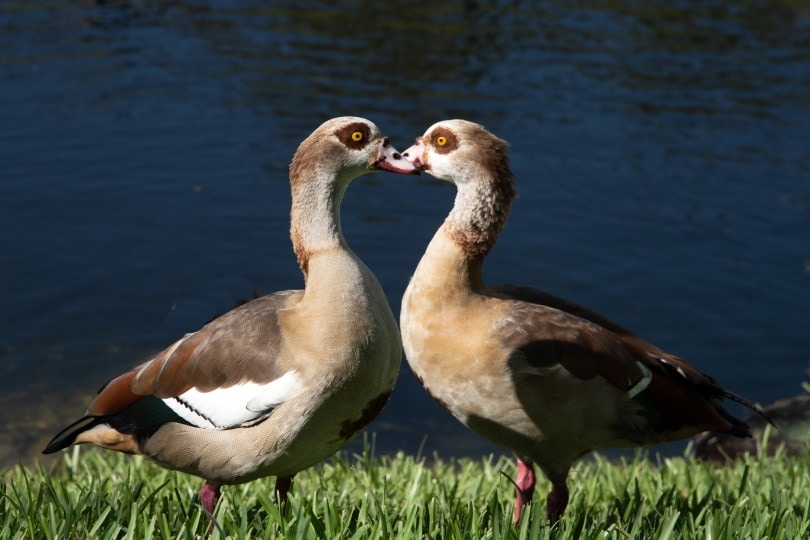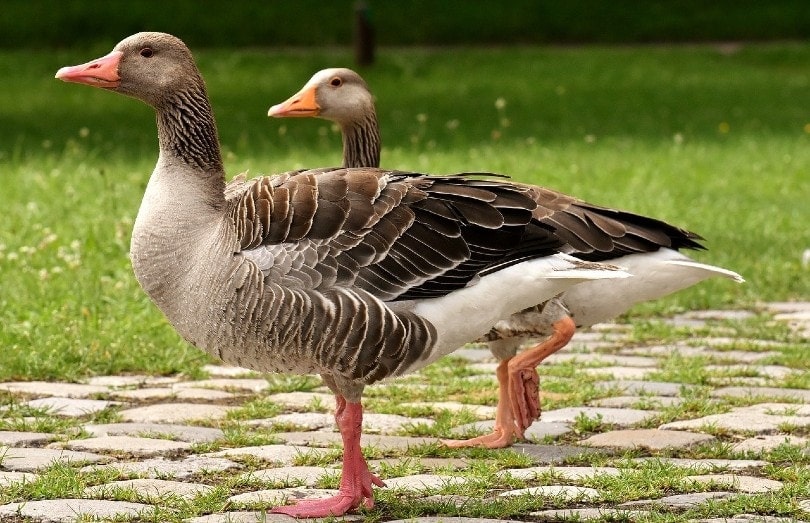Do Geese Mate for Life? It’s a Bit More Complicated Than That
Last Updated on

When you see geese, you typically see them in groups or flocks. After all, “birds of a feather, flock together,” as the saying goes. But does this also mean that geese only mate for a season, or do they actually mate for life?
You might be surprised to learn that geese do indeed mate for life. However, this does not mean they are monogamous.
Here, we get into the nitty-gritty details about how this whole geese/mating thing works. What exactly constitutes mating for life in a goose’s world, and what happens when one of the mates dies? Read on, and you’ll learn everything that you ever wanted to know about geese and mating.

Geese Are Like People
How geese hook up is much like how it is for us humans. Some geese prefer a soul mate and will bond with each other for life, while others prefer to play the field. In fact, some geese that are bonded may still take the time to try extra mating on the side with another goose.
Of course, if a gander attempts a tryst, he’ll be leaving his mate vulnerable to another male, or she might leave him completely for another gander. Unlike most humans, the life bond of geese isn’t necessarily romantic but is predicated on selfishness — the need to pass on his genes.

How Does Courtship Behavior Look?
During courtship behavior, like with many animals, many males will fight over the females, which sometimes occurs during the courtship between a male and female. They fight by beating each other with their wings and biting each other. The winner might get the female.
Courtship begins with the gander approaching the female by dipping his neck up and down gracefully as he slowly swims toward her. They face each other and will dip their heads up and down into the water together in unison. If the female continues this behavior, she’s accepted him as a partner, but if she moves away, he needs to try someone else.

Birds and Monogamy
Over 90% of birds form a pair bond. More specifically, these include Black Vultures, Ospreys, Loons, Golden and Bald Eagles and many Owls, Penguins, Puffins, and Swans.
Most of these birds are on the larger size, but there are smaller birds that also form pair bonds. Pigeons and Carolina Wrens are small birds that tend to mate for life.
Why Do Large Birds Pair Bond?
Large birds typically only produce one clutch of eggs each season. When you consider how complex and time-consuming courtship is for many birds, this process can end up delaying the production of the eggs. Therefore, having a partner already lined up makes things easier and much more efficient.
Additionally, it takes a long time for large birds to hatch their eggs because the incubation period is lengthy, and it also takes their young a while to leave the nest. So, it’s definitely easier for these birds to have a mate ready for breeding as soon as the season begins.
Bonding for life is much more of a practical practice rather than a romantic one.

The Benefits of Pair Bonding for Geese
In a world full of mammals where monogamy is uncommon, why do geese mate for life? There are several reasons that it works well for birds.
A 2011 study on the Greylag Goose showed that having a partner seemed to greatly reduce their stress. Biologists discovered that when a gander’s partner was in flight with him or nearby, his heart rate was lower, and he even seemed more relaxed. Additionally, the researchers found that the female’s heart rate rose when her mate was more than just a couple of feet away.
This study on the Barnacle Goose found that long-time bonded pairs of these geese were able to produce more offspring than those that hadn’t been bonded for as long. The longer the bond, the more successful the outcome.
A study of one of the most recognizable and common geese in North America, the Canada Goose, found that not only do the geese have better breeding success as bonded pairs, but their offspring also will themselves be much more likely to grow into adulthood to breed successfully. Their parents’ success leads to continued success for future generations.
Geese share parenting duties, everything from protecting their territory and their goslings to taking turns incubating the eggs and finding food. They also get better at raising their young every year, so their success rates increase with each progressive season.

Do Geese Ever Split Up?
Yes, they do. Parenting is a full-time job, even for geese. Once the goslings have hatched, both parents will stay with their young for at least 9 months to ensure their survival over the winter months. This is another reason that geese mate for life, but it can be exhausting.
Sometimes a goose needs a break, and this is when geese might split up. A study on Canadian geese divorce found that this can be a relatively common occurrence with birds that live long lives. The average lifespan of the Canada Goose can be about 12 years but can be as long as 24 years, so that’s a long time to be raising young!
So, it does happen that geese sometimes go their separate ways. This isn’t common, but the study did find that “divorcing” was likely to occur when they had produced fewer goslings the prior year. While one goose would choose a new mate and nest in the same area the following season, the other partner would usually skip a year or two before nesting again.
Related Read: Where Do Geese Sleep? How Do They Sleep?

When One of Them Dies
Unfortunately, a part of life is death, and sometimes one of the pair dies. More often than not, the goose left behind does eventually find a new mate and will form a new pair bond.
But in many cases, the goose will grieve. In this story, the goose stayed near the area where her mate died for 3 months, sometimes searching for him and occasionally keening.
She was eventually picked up by a wild animal rescue group, which ensured that she was eating and drinking. She was ultimately introduced to another male recovering from a broken wing.
So, while geese will likely grieve, they do tend to move on and pair bond again with another goose.

In Conclusion
Geese that mate for life are doing so for practical reasons and not so much for the romance. It helps ensure the success of their breeding, the incubating and hatching of the eggs, and the survival of their goslings. There are also other benefits, like lower stress rates and an increased number of eggs.
Going at it alone is difficult, particularly for wildlife, so a goose having a partner that can be relied on increases the success rate of their young. It also passes along those all-important genes.
See also:
- 23 Types of Geese Breeds: An Overview (with Pictures)
- Male vs Female Canada Goose: What’re The Differences? (with Pictures)
- Roman Goose
Featured Image Credit: dossyl; Shutterstock
About the Author Robert Sparks
Robert’s obsession with all things optical started early in life, when his optician father would bring home prototypes for Robert to play with. Nowadays, Robert is dedicated to helping others find the right optics for their needs. His hobbies include astronomy, astrophysics, and model building. Originally from Newark, NJ, he resides in Santa Fe, New Mexico, where the nighttime skies are filled with glittering stars.
Related Articles:
How to Clean a Refractor Telescope: Step-by-Step Guide
How to Clean a Telescope Eyepiece: Step-by-Step Guide
How to Clean a Rifle Scope: 8 Expert Tips
Monocular vs Telescope: Differences Explained (With Pictures)
What Is a Monocular Used For? 8 Common Functions
How to Clean a Telescope Mirror: 8 Expert Tips
Brightfield vs Phase Contrast Microscopy: The Differences Explained
SkyCamHD Drone Review: Pros, Cons, FAQ, & Verdict
